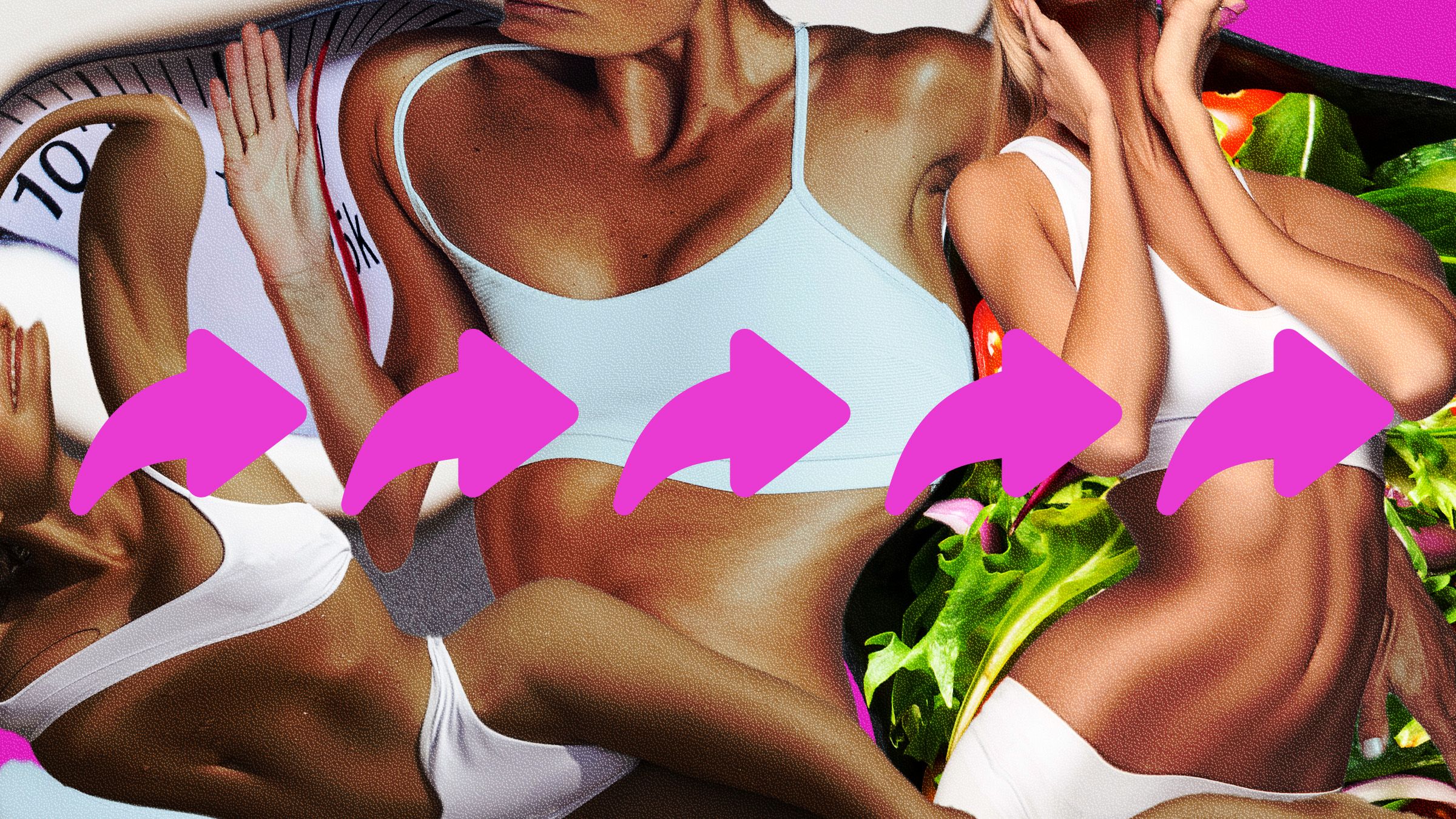Content warning: This piece includes descriptions of eating disorders and self-harm that may be triggering to some readers.
Soon after E turned 16, she started seeing TikToks that urged her to lose weight. People in the “SkinnyTok” community called them “harsh motivation.”
Some girls printed out photos of underweight models and taped them to their fridge doors. Others shared mantras to stop eating like: “You don’t need a treat, you’re not a dog.”
The phrase that stuck with E the most was “Your stomach isn’t growling, it’s applauding.” For around two months, she said she restricted calories to a dangerously low amount, because “that’s what they told me to do.”
“It felt so comforting and motivating to see those videos,” says E, who doesn’t want her name used due to privacy concerns. “There are so many accounts like these, which made me think ‘Oh yeah, this is normal’.”
It’s easy to find TikToks like the ones E described—but the platform is far from being an outlier. “SkinnyTok” is a genre of videos about weight loss, ranging from “harsh motivation” to food diaries showing what women eat to stay “lean.” It has been compared to “pro-anorexia” and “pro-eating disorder” communities that have thrived for over a decade on platforms like Tumblr. More recently, on X, pro-eating disorder groups have attracted hundreds of thousands of members through algorithmic recommendation. The groups proliferated after Elon Musk bought the platform in 2022, and users say they have flourished due to lack of moderation. TikTok says it has cracked down on these types of posts, saying pro-eating disorder content is banned on its platform and that it has taken other steps to mitigate the issue. But experts tell WIRED that both social media and the widespread nature of GLP-1 weight loss drugs (which are often advertised on the platforms) can be triggering, not only to people who are in recovery from eating disorders, but to people who have never struggled with them before.
Photo-illustration: Jacqui VanLiew; Getty Images
Now, some creators are releasing videos that poke fun at the absurdity of eating disorder content in an effort to dissuade others from buying into it. But experts say it’s a fine line between using humor to debunk and punching down.
One of the first results when searching “SkinnyTok” is a slideshow set to thumping electronic music and a young woman screaming “Control yourself!” The pictures in the slideshow feature the faceless bodies and hands of thin, young white women, as well as bowls of sliced carrots and blood oranges. Superimposed over the images are some of the same weight loss mantras E recalls. It has more than a quarter of a million views. According to TikTok’s tools for advertisers, videos with the “SkinnyTok” hashtag have been viewed over 53 million times in the past week. The advice ranges from the benign, like loading up on protein at the beginning of the day, to promoting extreme calories deficits and other forms of disordered eating in pursuit of thinness. Some women show “before” pictures and talk about how they lost dozens of pounds.
A 2021 survey of 273 women who used TikTok found that 64 percent had been “exposed to disordered eating content” on the “For You” page of the platform. TikTok has since added a feature to show eating disorder recovery resources to users who search terms associated with them, including “SkinnyTok.” The resources do not appear when searching for “harsh motivation,” which directs users to “harsh food motivation” and “harsh body motivation.” The platform also said it adjusted its algorithm to interrupt repetitive patterns of videos about weight loss.
In a statement to WIRED, TikTok says the 2021 survey “has significant limitations, does not reflect the experience of our community, and was conducted three years ago. We continually enhance our platform and policies to promote a positive and safe experience, and regularly consult with experts, remove content that violate our policies, and provide access to supportive resources.” TikTok also removed one video WIRED flagged that promoted skipping meals and drinking water instead.
But four practitioners tell WIRED patients in eating disorder recovery still bring up TikTok and “SkinnyTok” trends. Dr. Lauren Breithaupt, a Harvard Medical School clinical psychologist and cognitive neuroscientist who specializes in eating disorders, says “patients are reporting specific TikTok and Instagram trends that amplify their anxiety or trigger disordered behaviors.”
“Today’s adolescents don’t need to seek out pro-eating disorder content,” she adds. “It finds them.”
Eating disorders have the second-highest mortality rate of any mental health-related disorder. They have been on the rise worldwide for decades, doubling in the general population from 2000 to 2018. Then, between 2018 and 2022, health visits for eating disorders doubled in the US for kids and teenagers. In addition to the growing role of social media, weight loss drugs like Ozempic have become more accessible and popular. They have also been linked to eating disorders, with practitioners reporting that some patients are developing them after they begin taking GLP-1 drugs.
Breithaupt said there’s not one singular cause for an eating disorder, which involves biological, social, and psychological factors.
“But are there certain individuals where this overwhelming amount of content could lead to more disordered eating or down that path? Yes,” she says, adding that once someone engages with that content, the algorithms ensure that they see more.
E’s body image problems started when she was 12, but got worse because of social media. She says she first got on the internet to find ways to lose weight and found 15-minute workouts to do in the days leading up to wearing a swimsuit. “They would promote very underweight girls and make it seem like they were the ‘normal’ body. When I realized I don’t look like that, it made me feel bad,” E says.
Registered dietician Michelle Pillepich says SkinnyTok videos are often presented as if they’re promoting good health, but they’re actually regressive.
“It’s packaged in this message of ‘This is just to feel good, just to help you feel confident,’ but is selling and promoting weight stigma and bringing us back to the message of ‘thin makes you happy and you have to be skinny to be healthy,’” she says. “I thought we knew that thinness and health are not equal, but that’s really the message being sent again.”
During the Covid-19 pandemic, at the height of TikTok’s popularity, Pillepich started posting her own TikTok videos. Some of them “took off and got a lot of traction,” and she has almost 15,000 followers now. She sees the platform as an opportunity to share information about nutrition and eating disorders.
In early April, Pillepich posted a video asking viewers to “tell me the craziest most unhinged thing you did to motivate yourself to recover from an ED or disordered eating. I don’t mean ‘for my family.’ I mean the wildest thoughts that helped you eat when you really didn’t want to.” Nearly five million people watched and over 14,000 left comments. Some of the most-liked ones are, “a nail tech told me that she was going to start charging me extra cause ‘making gastric acid nails cute is hard,’” and, “For a while I imagined the ED thoughts being said by Trump so I wouldn’t wanna listen to them.”
“I am finding it very hopeful,” Pillepich says. “People do want to recover, they do want to feel better in their relationship with food.”
Around the same time Pillepich posted her video, E came across a creator named Stephen Imeh who she says was “unglamorizing” eating disorders with his blunt TikToks.
One of Imeh’s popular videos shows pictures of burgers, donuts, and other dishes as a retort to the idea that “nothing tastes as good as skinny feels.” His content regularly gets hundreds of thousands to millions of views.
Imeh, 19, a Houston-based college student, was initially drawn to a social media trend called “looksmaxxing,” where men and boys strive to improve their facial appearance down to the shape of their nose, jawline, eyes, and hairline. “Looksmaxxing” promotes tongue exercises, sucking in your cheeks, getting plastic surgery and disordered eating.
After posting a “looksmaxxing” video, Imeh, who is Black, says he received racist comments, including ones telling him to “just be white.” Upon realizing that the community was “toxic and racist,” Imeh pivoted to anti-looksmaxxing content and then stumbled on “SkinnyTok” and pro-eating disorder communities on X.
“It’s way easier to find SkinnyTok, eating disorder TikTok, than recovery,” Imeh said. “I went for a different approach, telling them the side effects and what could happen if you’re not eating.”
Imeh’s videos mention more extreme potential health outcomes of eating disorders, like organ failure and hair loss. But he also sometimes mocks the messaging found in pro-eating disorder communities. In one TikTok, he’s eating with a text overlay that says “none of your friends are gonna be jealous that your Ed made you look like a skeleton baby pick up the fork.”
Imeh says he’s not trolling, but stating “literal facts” that he doesn’t sugarcoat. “One thing I noticed in Gen Z, especially my generation, is that they will only stop doing something if they’re embarrassed by it,” he says.
“I got a lot of people emailing me and DMing me like ‘Stephen you’ve helped me so much with my eating disorder.’” He has over 70,000 followers, many of whom began following him after he took on eating disorder communities.
Pillepich says she can see a modern, “chronically online” approach working to redirect attention and ideally get people who need it into recovery.
“Leading with nuance doesn’t get people’s attention. It does have to be more extreme, more funny, whatever it is,” Pillepich said. “If that gets someone to the first step of seeing a dietician, a therapist, working on the deeper issues, then that’s great, too.”
Breithaupt said that content that is too judgmental or makes people with eating disorders feel ashamed could make them less likely to get help. “The most effective anti-ED content tends to validate the pain beneath the disorder while still rejecting the behaviors,” she says.
“When content creators use humor or mockery to push back against pro-ED culture, there’s a real risk that viewers—especially those actively struggling—won’t just see the disorder being criticized, they’ll feel like they are being mocked.”
E said that TikTok content like Imeh’s helped her realize how “stupid” SkinnyTok was. She said she has started watching eating disorder recovery content, instead. But the algorithm still shows her “harsh motivation” for weight loss in addition to recovery videos.
In late 2024, TikTok banned a controversial weight loss influencer whose content glorified extreme thinness. E thinks TikTok should ban more of “SkinnyTok,” although pro-eating disorder communities have historically migrated to other platforms when that happens.
Eating disorder recovery practitioners say that posting anti-��”SkinnyTok” videos on the same platform is likely helpful, but that it’s only a first step.
“What I work with most people on is limiting social media,” Breithaupt said. “Doing something else rather than engaging in social media is more helpful toward recovery, even if you’re watching recovery-oriented videos.”
The National Alliance for Eating Disorders Helpline provides support, resources and information about treatment options at 1-866-662-1235, Monday through Friday. You can also text “ALLIANCE” to 741741 if you are experiencing a crisis to be contacted by a trained volunteer. More information about eating disorders, including other free and low-cost support options, can be found on the National Eating Disorder Association’s website.



